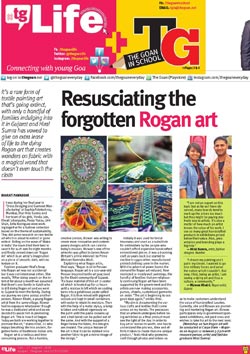
Resuscitating the forgotten Rogan art

It was during her final year in 'Dress Designing and Garment Manufacturing' at Sophia Polytechnic, Mumbai, that Hiral Sumra and her team of six girls, Venila Jain, Khyati Jobanputra, Pooja Yadav, Urvi Shah, Erifa Rodrigues were working together for a fashion collection based on the theme of sustainability. They did some research on rare textile art which is about to extinct or gone extinct. Riding on the wave of 'Make in India' the team tried their best to search for such rare for eight months and finally zeroed down on 'Rogan Art' which is an artist's imagination on a piece of smooth cloth, with no texture on it.
Fashion graduate Hirai's foray into Rogan art was not accidental but it was not intentional either. She recalls, "After doing search on the in- temet for about a month we assumed that there's one family in Kutch who is still doing Rogan art and we went to Gujarat to meet the family. During our journey we came across another person, Rizwan Khatri, a young Rogan artist from the same village. Rizwan had no exposure whatsoever though he was a dedicated artist and so we decided to assist him in promoting Rogan art. This is how it all began. Today we both are working together to promote the art," states Hiral, 22 who enjoys breathing life into ancient, forgotten forms of traditional Indian arts.
Rogan art is a tedious and time consuming process. But a humble, creative person, Rizwan was willing to create more innovative and contemporary designs which can cater to today's masses. Rizwan's one of the artworks was gifted to James Bevan (Britain's prime minister) by Prime Minister Narendra Modi.
Explaining what Rogan art is, Hiral says, "Rogan is oil in Persian language. Rogan art is a 300-year-old Persian inspired textile art practised by the Khatri community of Gujarat The base material of this art is castor oil which is heated up for 12 hours until a residue is left which on cooling turns into a gelatinous paste called Rogan. It is then mixed with pigment colours and kept in small containers with water to retain its moisture. Then with the help of a metal stylus, a lump is taken and rubbed vigorously on the palm until the paste loosens up and a trail (wire) can be pulled out of the same. And with the support of a finger below the fabric, the designs are created. The unique feature of the art is that it can be dabbed onto another fabric to get a mirror image of the design."
Initially it was used for bridal trousseau and used as a substitute for embroidery by the people who couldn't afford expensive handcrafted embroidered pieces. It was a booming craft 20 years back but started to decline in 1990s when manufactured printed clothing came in the market
With the advent of power looms the demand for Rogan art reduced. Now restricted to mostly wall paintings, the handful of families that are religiously continuing Rogan art have been supported by the govemment and the artists are now making accessories, purses, shawls, customised garments on order. "The art is beginning to see good days again," smiles Hirai.
"My aim is documenting the various crafts and textiles that' come across on my travels. The processes that an artwork undergoes before being exhibited as a final product must see the light of the day. In order to buy art or realise its worth, one has to understand the process, time and efforts it takes to create that one unique product," feels Hiral who promotes craft through photos and videos so as to make customers understand the value of handcrafted luxuries. Currently, she and Rizwan are promoting and marketing Rogan art. Rizwan participates only in government sponsored exhibitions, not paid ones and wishes to take his art to the next level.
(Workshop on Sun Rogan art will be conducted at Carpe Diem — Majorda on August 12 between 3-7 pm with resource person, artist and fashion graduate Hiral Sumra)
"I am not an expert on this topic but as far as I have observed, many bran ds tend to mark up the prices too much but they might be paying relatively less to artists. It's also a matter of how much an artist knows the value of his work. I see so many great handcrafted products in exhibitions priced below their value. Also, presentation and bran ding plays a big role."
— Hirat Sumra, artist, fashion designer, Mumbai
"I dream my painting and paint my dream. I wanted to go into military forces and serve the nation which I couldn't. But now, I feel, being an artist, I am saving a dying art and thus a culture, a community."
— Rizwan Khatri, Ruan arist Gujarat





